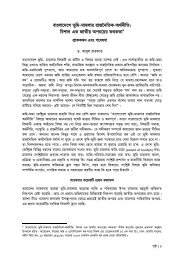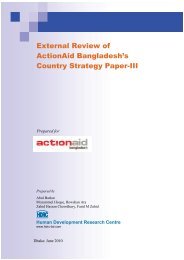08. Costing Essential Services Package An Issue Paper
08. Costing Essential Services Package An Issue Paper
08. Costing Essential Services Package An Issue Paper
Create successful ePaper yourself
Turn your PDF publications into a flip-book with our unique Google optimized e-Paper software.
<strong>Costing</strong> <strong>Essential</strong> <strong>Services</strong> <strong>Package</strong>: <strong>An</strong> <strong>Issue</strong> <strong>Paper</strong> 13<br />
Expenditure for direct ESP<br />
Delivery (59.54% of HPSP)<br />
Figure 10: PPC ESP <strong>Costing</strong> (Year 1)<br />
Total ESP Expenditure<br />
RSD ISS<br />
Before proceeding further into the methodological analysis, it would be pertinent to state that<br />
initially, before the pre-appraisal, a top-down costing procedure was followed; then after the preappraisal,<br />
a bottom-up approach was tried; and finally, during the appraisal, a combination of<br />
top-down and bottom-up procedure was followed and final costing (or to be technically correctexpenditure<br />
estimates) was done keeping in view the realistic or available resource envelope.<br />
PPC’s method of estimating costs, as presented in the HPSP document states that “Proper<br />
formulation of an expenditure plan for a number of years requires adoption of a systematic<br />
method. The systematic method involves:<br />
� setting the targets in terms of impacts and effects;<br />
� quantify the volume of outputs to be produced to achieve each of the targeted impacts;<br />
� compute the input-coefficients;<br />
� check joint-inputs and remove duplication;<br />
� obtain a dynamic input-output model;<br />
� calculate costs of inputs at the market price; and<br />
� adjusting the costs for different years using the appropriate inflator (or deflator).<br />
But the data required for carrying out rigorous exercises using the systematic method were not<br />
available. Therefore, we had to adopt a method which combines the systematic method with<br />
the crude method: we remain systematic in approach and moved through a chain of steps, but<br />
use of notional figures in the case of a number of specific cost items could not be avoided”<br />
(HPSP, PIP, Part 1, GoB 1998a : 70-71).<br />
PPC has estimated the expenditures for HPSP by eight components and associated activities.<br />
The components as shown in Figure 2, are:<br />
1. <strong>Essential</strong> <strong>Services</strong> <strong>Package</strong> (ESP)<br />
2. Reorganization of Service Delivery (RSD)<br />
3. Integrated Support <strong>Services</strong> (ISS)<br />
4. Hospital Level <strong>Services</strong> (HLS)<br />
5. Sector wide Management (SWM)<br />
HLS SWM PRNP OPHS OHNS<br />
Expenditure for other than ESP service delivery<br />
components of HPSP (25.56%)






